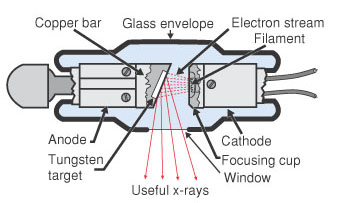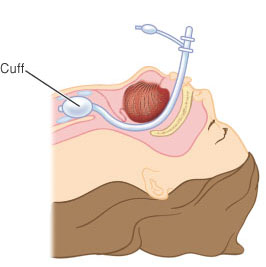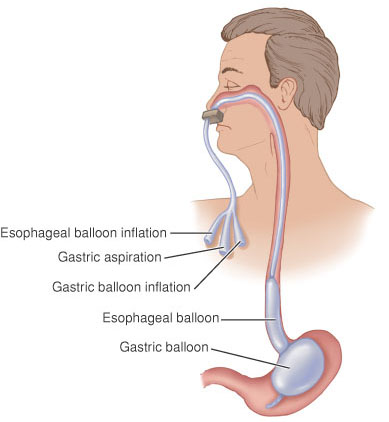| tube | |
| an elongated hollow cylindrical organ or instrument. | |
| Tube | |
| Abbott-Miller tube, Miller-Abbott t. | |
| Abbott-Rawson tube, a double-barreled stomach tube, through which fluid may be both injected and aspirated; it may be used for lavage or decompression of the stomach. | |
| air tube, airway.any tubular passage of the respiratory system; see trachea, bronchus, and bronchiolus. | |
| auditory tube, tuba auditiva. | |
| balloon tube, see under catheter. | |
| Bouchut tubes, a set of tubes for use in the intubation of the larynx. | |
| Bowman tubes, tubes formed artificially between the lamellae of the cornea in the process of injection; called also corneal t's. | |
| buccal tube, see end t. | |
| Cantor tube, a mercury-weighted intestinal tube for decompression of the small intestine or removal of an obstruction. | |
| Carlens tube, an early type of endobronchial tube equipped with a small hook to hold it in position at the tracheal bifurcation; used for ventilation of the left lung. | |
| cathode-ray tube, a vacuum tube in which the cathode rays are accelerated as a beam to form luminous spots on a fluorescent screen. | |
| Celestin tube, a plastic tube used to keep the esophagus open in inoperable esophageal carcinoma. | |
| cerebromedullary tube, neural t. | |
| Chaoul tube, a low voltage x-ray tube designed with the anode at 2 cm from the body, allowing intense but superficial tissue penetration of the ionizing radiation beam. | |
| chest tube, a tube inserted into the thoracic cavity for the purpose of removing air or fluid, or both; it is attached to a closed drainage system so that normal pressures within the alveoli and the pleural cavity can be restored. These pressures are essential to adequate expansion and reinflation of the lung. | |
| Coolidge tube, a vacuum tube for the generation of x-rays in which the cathode consists of a spiral filament of incandescent tungsten and the anode (the target) of massive tungsten. | |
| corneal tubes, Bowman t's. | |
| Craigie tube, a tube apparatus used for separating motile from nonmotile bacteria; it consists of a length of glass tubing with slanted bottom inserted into a larger tube of semisolid culture medium with the top of the smaller tube protruding above the medium. The medium is inoculated by stab inside the smaller tube. Organisms isolated from the medium outside the tubing are motile; nonmotile types remain inside. | |
| digestive tube, see under tract. | |
| discharge tube, a vessel of insulating material (usually glass) provided with metal electrodes which is exhausted to a low gas pressure and permits the passage of electricity through the residual gas when a moderately high voltage is applied to the electrodes. | |
| drainage tube, a tube used in surgery to facilitate the escape of fluids. | |
| Durham tube, [Arthur Edward Durham] a jointed tracheostomy tube.[Herbert Edward Durham] a small inverted test tube used in determining bacterial gas production. | |
| empyema tube, a tube for draining an empyema from the thoracic cavity. | |
| end tube, an orthodontic attachment on the buccal surface of a terminal banded molar; often referred to as buccal t. when using an edgewise arch mechanism. | |
| endobronchial tube, a double-lumen tube inserted into the bronchus of one lung and permitting the complete deflation of the other lung; used in anesthesia and thoracic surgery. | |
| endocardial tubes, endocardial heart tubes, paired, longitudinal, endothelial-lined channels formed from the cardiogenic mesoderm in embryonic development; they fuse to form the primordial heart tube. | |
| endotracheal tube, a tube inserted into the trachea through the mouth, the nose, or a tracheostomy for administration of anesthesia, maintenance of an airway, aspiration of secretions, ventilation of the lungs, or prevention of entrance of foreign material into the tracheobronchial tree. Called also tracheal t. | |
| esophageal tube, a tube going into or through the esophagus.stomach t. | |
| eustachian tube, tuba auditiva. | |
| Ewald tube, a stomach tube of large bore, used to evacuate the stomach. | |
| fallopian tube, tuba uterina. | |
| feeding tube, a stomach tube used to introduce fluids of high caloric value. | |
| fermentation tube, a U-shaped tube with one arm closed for determining gas production by bacteria. | |
| fusion tubes, heteroscope. | |
| gastrostomy tube, a tube inserted through a stoma on the body surface into the stomach in a gastrostomy. | |
| germ tube, the short tube formed by a germinating hypha, conidium, or yeast cell; see also germ tube test, under test. | |
| Harris tube, a single-lumen intestinal tube with a mercury weight, similar to the Miller-Abbott tube, used as a diagnostic aid in study of the small intestine. | |
| heart tube, primordial heart t. | |
| horizontal tube, a metal tube attachment placed in a horizontal position on the buccal surface of each anchor molar. | |
| hot-cathode tube, a vacuum tube in which the cathode is electrically heated to incandescence and in which the stream of electrons depends on the temperature of the cathode. | |
| intestinal tube, a tube into the intestines, inserted for therapeutic measures. | |
| laryngotracheal tube, the embryonic endodermal tube that is split off from the primordium of the oropharynx and esophagus when the tracheoesophageal septum divides the cranial part of the foregut; it constitutes the primordium of the larynx, trachea, bronchi, and lungs. | |
| Levin tube, a type of nasogastric tube used for decompression of the stomach. | |
| medullary tube, neural t. | |
| Miller-Abbott tube, a double-channel intestinal tube with an inflatable balloon at its distal end, for use in the treatment of obstruction of the small intestine; occasionally used also as a diagnostic aid. | |
| nasogastric tube, a tube of soft rubber or plastic inserted through a nostril and into the stomach, for instilling liquid foods or other substances, or for withdrawing gastric contents. | |
| nasotracheal tube, an endotracheal tube that passes through the nose. | |
| nephrostomy tube, a tube inserted into the renal pelvis for direct drainage of the urine through a percutaneous nephrostomy opening. | |
| neural tube, the neuroepithelial tube developed from the neural plate and forming the central nervous system of the embryo; called also medullary t. and cerebromedullary t. | |
| Olshevsky tube, an x-ray tube constructed to use only the stronger rays which pass through the target and armoring the rest of the tube. | |
| orotracheal tube, an endotracheal tube that passes through the mouth. | |
| otopharyngeal tube, tuba auditiva. | |
| ovarian tubes, groups of cells that grow down and are cut off from the thickened surface layer of the ovary; they surround the primordial sex cells, which develop into primary oocytes, each with a follicular layer. | |
| pharyngotympanic tube, tuba auditiva. | |
| photomultiplier tube, a vacuum tube that converts electromagnetic radiation signals into electrical pulses, consisting of a light-sensitive surface that emits electrons when light is incident on it, the electrons then passing through successive stages with electron multiplication at each stage. | |
| polar tube, a hollow, extensible, filamentous tubular organelle found coiled in the spore of microsporidan protozoa, through which the sporoplasm is injected into the host's tissues. Called also polar injecting filament. | |
| primitive heart tube, primordial heart tube, the primordium of the heart, formed by fusion of the two lateral endocardial tubes. | |
| Robertshaw tube, an endobronchial tube that has various improvements over the Carlens tube such as lack of the positioning hook and availability for ventilation of either lung. | |
| Roida tube, a tube designed for the separation of motile from nonmotile bacteria; the motile organisms make their way through sand, glass-wool, and other obstructions. | |
| roll tube, see roll-tube culture, under culture. | |
| Ruysch tube, a very small tubular opening on the nasal septum, just anterior and inferior to the nasopalatine foramen: it is a relic of the fetal Jacobson organ. | |
| Ryle tube, a thin, flexible stomach tube with an olive-shaped end, used in giving a test meal. | |
| Sengstaken-Blakemore tube, a multilumen esophageal tube used for the tamponade of bleeding esophageal varices. One lumen leads to a balloon that is inflated in the stomach, to retain the instrument in place, and to compress the vessels around the cardia; another leads to a long narrow balloon by which pressure is exerted against the varices in the wall of the esophagus; and a third provides for aspirating contents of the stomach. | |
| sputum tube, a graduated capillary tube for containing sputum to be rotated in the centrifuge. | |
| stomach tube, a tube for feeding or for irrigation of the stomach; the most common types are the nasogastric tubes. | |
| T tube, a self-retaining drainage tube in the shape of a T. | |
| test tube, a tube of thin glass closed at one end, used for various procedures in chemistry and for the growth of bacterial or viral cultures. | |
| thoracostomy tube, a tube inserted through an opening in the chest wall, for application of suction to the pleural cavity; used to drain fluid or blood or to reexpand the lung in pneumothorax. | |
| tracheal tube, endotracheal t. | |
| tracheostomy tube, a curved endotracheal tube inserted into the trachea through the opening made in tracheostomy. | |
| tympanostomy tube, ventilation t. | |
| uterine tube, tuba uterina. | |
| vacuum tube, a glass tube from which the air has been exhausted to a high degree of vacuum. | |
| valve tube, a vacuum tube used to rectify an alternating current. | |
| Veillon tube, a piece of glass tubing with a rubber cork at one end and a plug of cotton at the other, used in bacterial culture work. | |
| ventilation tube, a tube inserted after myringotomy in chronic cases of middle ear effusion, such as in secretory or mucoid otitis media; it provides ventilation and drainage for the middle ear during healing. Called also tympanostomy t. | |
| vertical tube, an orthodontic attachment usually placed on the lingual surface of the anchor band to allow for the insertion of the lingual arch wire. | |
| Westergren tube, a straight glass pipette 30 cm long and 2.5 mm in internal diameter, marked in millimeters from 0 to 200 and used in the Westergren method of determining the erythrocyte sedimentation rate. | |
| Wintrobe hematocrit tube, a thick-walled glass tube with a uniform internal bore, a flat bottom, and millimeter calibrations from 0 to 105; used in the Wintrobe method of calculating hematocrit. | |
| x-ray tube, a glass vacuum bulb containing two electrodes. Electrons are obtained either from gas in the tube or from a heated cathode. When suitable potential is applied, electrons travel at high velocity from cathode to anode, where they are suddenly arrested, giving rise to x-rays. | |
| Standard stationary anode x-ray tube; diagram in longitudinal section. | |
 |
|

 |